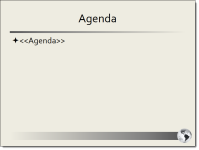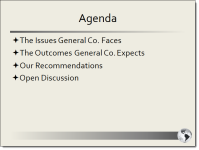The Agenda Slide subsection is used to create a component in which you can add a slide to be used as a table of contents or introduction for the presentation that users can build. During the building of a presentation, users will be able to select the slides that will be listed in the Agenda Slide component. The title of each selected slide will display as a bullet in the text area containing the Agenda Slide code.
Note: The "IncludeAllSelectionsInAgenda" Global Setting must be enabled to select your selection items on an Agenda slide.
The slide as added to the Agenda Slide component in the document type (left) and as part of the finished presentation (right).
Create an Agenda Slide Component
- From the Toolkit, select Agenda Slide.
- In the Properties panel, enter the name of the component. This name displays in the Navigation panel.
- Enter the display title. This title displays on the created document's Assemble tab.
- From the Actions menu, select Upload Document, click the ellipsis to browse to the desired Microsoft PowerPoint file, select the file, click Open and then click Save.
- From the Actions menu, select Edit. The file opens in PowerPoint.
- Do the following to format the slide in PowerPoint:
- Click inside the placeholder where you want to add the agenda.
- From the Qvidian Toolbar, click Add Agenda Code.
- Click Save to Qvidian.
- Select one of the following options from the Include drop-down menu:
- Always: Select if you want this subsection required for completion for created documents or projects using the document type.
- Optional: Select if you want this component to be listed in the Optional Tasks panel on a created document's Assemble tab or on a project's navigational panel so that end users have the option of including the component.
- By inclusion:Select if you want this component automatically included when an optional component is included. The Component / Selection Group tree displays listing the optional component and selection groups for this document type. Check the box for the optional component with which you want to associate this component. When the user includes the associated optional component, the by inclusion component is also included. Check the boxes for each item that you want this component included with a required for completion status.
- Optional or by inclusion: Select if you want this component included either as an optional component or to be included by inclusion of a different optional component. The Subsection / Selection Group tree displays listing the optional components and selection groups for this document type. Check the box for the optional component with which you want to associate this component. When the user includes the associated optional component, the by inclusion component is also included. The component is also listed in the Optional Sections pane on the created document's Assemble tab or on the project’s navigation panel, so that users can select the component in a document build without selecting the component with which it is associated.
- Click Save.
Remove an attached content record
- Select Delete from the Actions Menu. The Confirm Deletion dialog displays.
- Select one of the options below:
- Remove link(s) to content: Select if you just want to remove all links to the content you are deleting.
- Remove link(s) to content, and, if permissioned, delete content from the Library: Select if you want to remove all links to the content and delete the content stored in the library.
- Click Yes.
Additional actions
From the Actions menu, you can perform additional tasks to work with the content records that are attached to your component:
- Edit content: Select Edit to open the file in PowerPoint. You must edit the content using the Qvidian toolbar, or your changes will not be saved.
- Cancel an edit: Select Cancel Edit to cancel the editing of a document or presentation and abort any changes made. The file must be currently open via the Edit function.
- Download a content record: Select Download to download the content. You will be prompted by your browser to save the file.
- View content record properties: Select Properties to view or edit the title of the slide.
- Preview attached content record as an image: Click the content record title next to the Actions menu. The Preview Image dialog displays in full page view.
The Agenda Slide toolbar displays when you edit a PowerPoint slide that has been uploaded to an Agenda Slide component.
Save to Qvidian
- Click the Save to Qvidian button to save your changes after you are finished with your document. The Upland Qvidian login dialog box may display. If you are saving new content, the Submit Content dialog box displays where you can add details to the content before submitting the content to the specified folder.
Cancel / Cancel All
- Click Cancel or Cancel All to cancel the editing of the current content record or all content records and close without saving any changes.
Add Agenda Code
- Click the Add Agenda Code button to add the agenda merge code to a slide in a Agenda Slide component .
Delete Temporary Content
-
Click Tools, and then select Delete Temporary Content to delete temporary content that Upland Qvidian creates when a user performs an upload or any editing functions.
Note: You may want to periodically remove temporary content to free up disk space.
Select Server
This function is provided for users who use different Upland Qvidian databases on different servers to manage content. It allows you to save the presentation to a specific server running Upland Qvidian.
- On the toolbar, click Help then select Select Server to display the Default Qvidian Server page.
- Select the Qvidian Server. If the Qvidian Server URL is not listed, click in the field and type in the server's URL, verifying that http:// precedes the URL and a single slash - / ends the URL.
Change Login
- On the toolbar, click Help then select Change Login to display the Upland Qvidian login page.
Note: If you need additional assistance in the Upland Qvidian Login page, click Directions.
- Enter your user name and password. If logging in as a different user, make sure this user has a user account which is enabled in Upland Qvidian.
Note: Once logged in, you will not have to log in again when performing any operation, such as Save to Qvidian, that requires interaction with the Upland Qvidian web application from within this Microsoft Office product (Word, PowerPoint, or Excel) session.
- Select the Use single sign-on check box if your organization is using a single sign-on approach, such as Active Directory (ADSI), Siteminder, or Ping to configure your user account in Upland Qvidian.
- Select the Remember these settings check box if you want the application to remember either your explicit user name and password, or your single sign-on setting. These settings are remembered from Upland Qvidian session to session unless you log in as a different user or change your login credentials.
- When completed, click Login/Set.
Reset Your Login Credentials
- In the Upland Qvidian Login page, click Clear to reset the User Name and Password to empty, "single sign-on" to off, and close any current server connection. The next time any connection is made to the server, the user will be prompted for their login credentials.

